From the smooth sculptural curves and
organic white lines branching across the building exterior to the
sparkling glass facade and award-winning architecture - the
spectacular Victorian Comprehensive Cancer Centre (VCCC) bears
striking similarities to a world-class modern art museum.
Designed by Silver Thomas Hanley, DesignInc and McBride Charles
Ryan and located in Melbourne's Parkville Biomedical Precinct,
the state-of-the-art facility is the first comprehensive cancer
centre in Australia and represents a collaboration that aims to
save lives through the integration of cancer research, education
and patient care to create a leading centre of excellence.
The $1 billion purpose-built VCCC was designed to maximise functionality and sustainability, all whilst
boasting cutting-edge design and technology to reflect the superior minds working within the centre.
Aiming to be one of the world's top ten facilities of its kind, the VCCC takes sustainability seriously,
embracing opportunities to increase energy efficiency and reduce the emission of greenhouse gases.
With sustainability in mind, Australia's leading manufacturer and distributor of premium residential and
commercial lighting, Gerard Lighting helped VCCC achieve its sustainability goals by offering functional,
efficient lighting that meets the needs of the versatile health care facility.
Gerard Lighting alongside Downer Group was tasked with developing and delivering a range of suitable
lighting products, as specified by the project's engineers and architects. Required to match the
architecture and aesthetics of the advanced hospital and research facility, as well as to meet the strict
requirements of the building's AS1680 Interior Lighting Standard - Gerard Lighting ensured the chosen
lighting systems were compatible with the state-of-the-art building management system to deliver
appropriate light levels to staff, patients and visitors in a pleasing and efficient manner.
Gerard Lighting, together with one of their architectural lighting
specialist Inlite, offered a blend of fluorescent and LED lighting
products for the project and supplied a variety of bespoke
commercial, architectural and medical luminaires - customised
according to the specific requirements of the project and each
individual application.
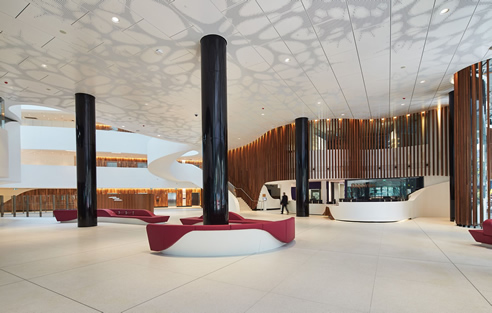
All of the downlights installed utilised energy efficient LED
solutions to maximise performance and service life whilst
minimising power consumption, outages and maintenance
expense. The benefits of using DOT downlights included
high quality aluminium reflectors and high performance
CREE LEDs to maximise output and distribution. Many of the
luminaires including the cleanroom luminaires and extruded
forms were redesigned to incorporate monitored
emergency lighting modules to improve efficiencies in
installation and minimise ceiling perforations particularly in
a sealed and clean hospital and laboratory environment.
Healthcare lighting has been one of the core focus areas for Gerard Lighting. Recognising the importance
in providing quality and sustainable lighting to healthcare facilities, research by Gerard Lighting has
revealed how constant lighting can drastically improve care quality and reduce anxiety experienced by
patients¹. Lighting can benefit both staff and patients by providing comfortable levels of light to help
influence health and wellbeing. A well-illuminated workplace can improve productivity and energy levels
across the working day. Using different colours, dimming and control of light can enhance the visual
environment and help patients and families feel more comfortable and relaxed in what can be very
stressful place and time.
¹ https://specify.gerardlighting.com.au/about-us/healthcare-lighting-solutions
Lighting control systems have also been beneficial for healthcare facilities, allowing staff to adjust
lighting to cater for individual needs, such as dimmable lighting for recovery and bright lighting for
patient care activities and monitoring.
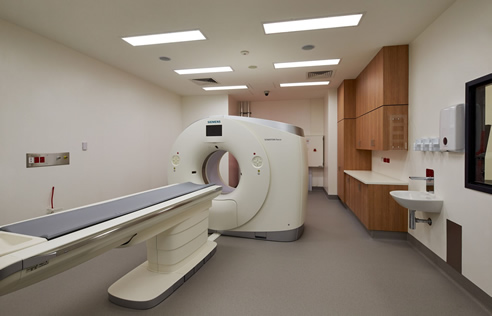
"Over 38,000 luminaires were used in patient wards and treatment areas, research laboratories,
circulation and breakout spaces, car parks and exterior zones. These luminaires were designed and
chosen specifically to suit each individual application and environment. In each respect it was critical
that the light fittings could be easily cleaned, were robust in build and incorporated DALI dimmable
control gear, LED lamps or light engines to maximise service life and minimise power consumption and
maintenance," says Ben Mills, General Manager at Gerard Lighting.
Installation and customisation in sensitive areas such as the research facility was a challenging aspect of
the project explains Mills. Gerard Lighting also provided light fittings in MRI rooms bunkered several
stories underground. To protect the MRI scanning equipment, physicians and patients and to align with
the requirement of a 'metal free product zone', non-magnetic luminaires were built and installed in
these rooms.
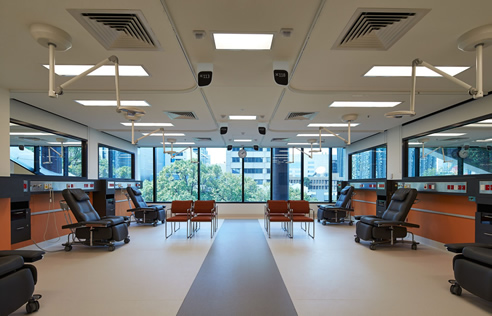
"Gerard Lighting was involved very early in the selection of luminaires for the project with the electrical
services engineer and Downer Group to ensure a compliant and sustainable solution was delivered that
met the expectations and stringent requirements of the client. Taking into consideration all elements,
aspects and requirements of the project, the Melbourne based project team, in direct communication
with engineering and category in Sydney, assisted in the design, build and supply of 250 different
models and variations of luminaires to site whereby 75 per cent of these fittings were manufactured
here in Australia," says Mills.
Once all fittings were installed, Gerard Lighting, Downer Group and Grocon engineers spent two weeks
overseeing a detailed light level survey of the hospital to ensure its compliance with the respective
lighting standards and levels required by the hospital.
A now iconic piece of Melbourne architecture, the VCCC is both a world-class facility for the education
and treatment of cancer patients, as well as a design masterpiece.
For further information on Gerard Lighting visit www.gerardlighting.com.au
Images supplied by Peter Bennetts, Courtesy Plenary Group.
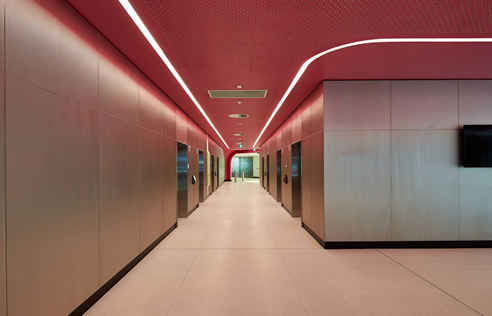


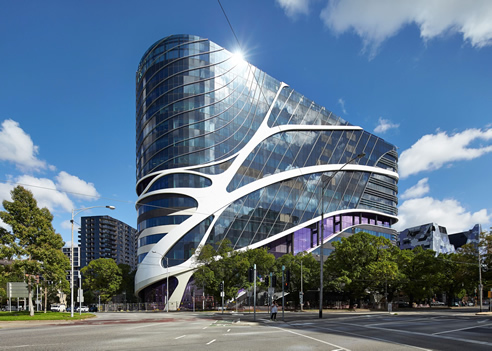






 Frisbee Head LED Bollards by Pierlite
Frisbee Head LED Bollards by Pierlite Low Glare Suspended Light for Offices by
Low Glare Suspended Light for Offices by Compact LED Floodlight by Pierlite
Compact LED Floodlight by Pierlite Warehouse Lighting by Pierlite
Warehouse Lighting by Pierlite Smart Scan Sensor for Lights by Pierlite
Smart Scan Sensor for Lights by Pierlite LED Lighting Replacement for Carpark by
LED Lighting Replacement for Carpark by Lighting with IoT Sensors from Pierlite
Lighting with IoT Sensors from Pierlite Slimline LED Floodlights - Crompton
Slimline LED Floodlights - Crompton Cloud-Based Sports Field Lighting
Cloud-Based Sports Field Lighting Touch-Screen Lighting Management for
Touch-Screen Lighting Management for New Lighting Innovation Centre Sydney
New Lighting Innovation Centre Sydney Sustainable Lighting Company Gerard
Sustainable Lighting Company Gerard LED Luminaires With Integrated Sensors
LED Luminaires With Integrated Sensors Human-Centric LED Troffer Lighting from
Human-Centric LED Troffer Lighting from Smart Home Lighting Control from Gerard
Smart Home Lighting Control from Gerard Tunable White Luminaires - Siteco
Tunable White Luminaires - Siteco Three Colour Temperature Luminaires from
Three Colour Temperature Luminaires from Human Centric Lighting (HCL) with Gerard
Human Centric Lighting (HCL) with Gerard Sylvania Briteline Raptor LED Floodlight
Sylvania Briteline Raptor LED Floodlight Lighting Design and Control | Gerard
Lighting Design and Control | Gerard
